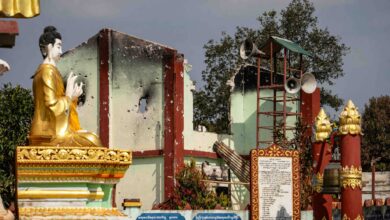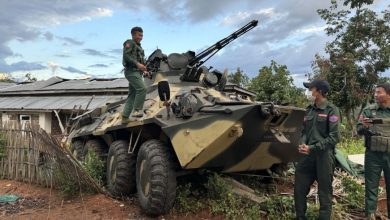
Conflict along Myanmar’s eastern border with Thailand has recently begun to receive international media attention due to its intensification since the military seized power on February 1. However, clashes in the region actually began in January, with dozens or perhaps even hundreds of hit-and-run attacks, skirmishes, and full-blown battles occurring since then between the Myanmar military and the Karen National Liberation Army (KNLA), according to civilians and combatants in the area.
In fact, it was not until March 27, when the Tatmadaw, or Myanmar military, began carrying out airstrikes on ethnic Karen villages in retaliation for the capture of a Tatmadaw base in KNLA-controlled territory that the world began to take notice of the situation in eastern Myanmar’s Kayin State. The chief reason for this is that it triggered an exodus of Karen villagers seeking refuge across the border in Thailand. When Thai authorities turned them back, Thai and foreign journalists flocked to the border village of Mae Sam Laep (also known as Thaw Le Hta) in Thailand’s Mae Hong Son Province to report on an emerging humanitarian crisis.
But even before the conflict on the Myanmar side of the border began to directly impact on Thailand, reports that the Thai authorities had tried to provide 700 sack of rice to Tatmadaw troops based in camps along the Salween River raised questions about Thailand’s stance on the broader struggle playing out in Myanmar since the coup.
Although the Thai army has denied any role in providing supplies for Myanmar troops, well-informed sources on the border have confirmed that the Tatmadaw had sought assistance from the Thai authorities to transport the rice by boat on the Salween River, which forms part of the border between the two countries. This was necessary because hit-and-run attacks by the KNLA had cut off Tatmadaw supply lines, making it impossible to transport goods overland by truck, horse or foot to frontline bases.
These attacks, carried out on an almost daily basis in KNLA Brigade 5-controlled territory in Kayin State’s Hpapun, or Mutraw, District, have also resulted in heavy casualties. Ambushes, snipers and landmines have killed or injured at least 300 Tatmadaw troops in northern Kayin State since the outbreak of hostilities in January, according to KNLA estimates.
Crossing the line
Deprived of access to supplies, some troops have resorted to extraordinary measures to meet their needs. On March 23, for instance, a group of five soldiers swam across the Salween to buy rice, oil, dried foods and whiskey in Tha Ta Fang, another village in Mae Hong Song Province. According to a witness, the soldiers were greeted in a friendly manner by their Thai counterparts, who took no action against them despite a ban on border crossings due to Covid-19 restrictions. The Thai soldiers also told locals to refrain from taking photographs of the Tatmadaw soldiers and the provisions they purchased in Thailand, the witness said.
For the return journey to their base at Dah Gwe, on the Myanmar side of the river, the soldiers took a boat belonging to a Thai-Karen resident of Tha Ta Fang, which is also known as Mae Kha Hta. Although the boat was eventually returned, it was unclear if the owner had much choice in the matter of lending it to the “visitors” from across the border. Again, this met with no objection from the Thai authorities.
More often, however, the Myanmar troops have relied on plunder on their own side of the border to procure food and other necessities. To do this, they have fired artillery into villages, forcing their inhabitants to flee and leave most of their belongings, including rice and livestock, behind.
On April 17, troops based at Dah Gwe also opened fire on boats owned by Thai-Karen villagers as they were being used to transport emergency supplies to refugees displaced by the threat of airstrikes. Local villagers who witnessed the incident said that a number of bullets reached the Thai side of the river, but this failed to provoke any reaction from Thai troops stationed there to defend the border.
A week later, on April 24, another boat came under fire at the same location, this time carrying Thai border patrol police. Two days after this incident, Thai authorities met with Tatmadaw representatives to discuss what happened. The two sides reached an agreement whereby boats carrying aid and supplies would be allowed to travel freely on the river, and the Thai foreign ministry expressed regret over what its spokesperson Tanee Sangrat called a “misunderstanding”.

Siding with the Tatmadaw
This episode highlighted what many local villagers living on the border see as evidence of the Thai authorities’ discriminatory attitude towards Karen refugees, which stands in stark contrast to their cordial relations with Myanmar troops who have openly violated Thai sovereignty.
Another illustration of this was the reaction to the brief presence of refugees on Thai territory before they were turned back. A photo published by Thai media showed a man in full PPE sanitizing rocks that had come into contact with refugees. This bizarre display, which was evidently intended to demonstrate Thai concerns about the public-health risks posed by the refugees, met with widespread criticism on social media.
Meanwhile, residents of Tha Ta Fang who witnessed airstrikes on the other side of the border told Myanmar Now that they saw a Myanmar military jet fly over their village before dropping bombs inside Kayin State—further proof, in their view, that Thailand is siding with the Tatmadaw in its conflict with the KNU, despite international condemnation of the Myanmar regime.
“The Thai authorities support the Myanmar military. They didn’t respond even though the Tatmadaw soldiers were very aggressive, shooting at Thai border patrol police,” said Naw Moo, a resident of Mae Sam Laep.
Other observers have also noted Thailand’s reluctance to allow any action that might displease the Myanmar regime. Journalists who travelled to the border to report on the plight of the refugees say the Thai military denied them permission to conduct interviews with Karen villagers fleeing from airstrikes, while relief groups say that Thai authorities in Mae Sam Laep initially blocked efforts to transport aid to the refugees.
Meanwhile, the pushback has left thousands of Karen villagers vulnerable to attack, forcing them to seek shelter in caves or in the jungle, where their health and safety is at great risk.
“It is very hard for me to live in the jungle because I have two kids and the younger one is just a month old. Sometimes we live in the rain and sometimes we live in the heat,” said Beh Beh, a young mother whose home village was one of several hit by airstrikes after the KNU captured a Tatmadaw base opposite Mae Sam Laep last Tuesday. Like most villages in the area, however, it was already empty, as its inhabitants had fled in late March, hoping to find refuge in Thailand.
Worse to come
It seems unlikely that tensions will ease anytime soon. According to KNLA sources, Brigade 5 aims to take control of all bases along the Salween if the Tatmadaw doesn’t withdraw its troops from the border. The KNLA says this is something that Karen civilians living in the area have long called for, as the presence of Myanmar troops close to their communities, including the Ei Tu Hta camp for internally displaced persons, prevents them from living and working without fear.
The Tatmadaw, meanwhile, appears to be digging in, setting the stage for an intensification of fighting and further displacement of civilians. The junta’s spokesperson, Maj-Gen Zaw Min Tun, has accused the KNLA’s Brigade 5 of violating the Nationwide Ceasefire Agreement, which the Karen National Union, the political wing of the armed group, signed in 2015. The KNLA has denied this, and says it is prepared to face anything the Tatmadaw wants to throw at it.
“Airstrikes are nothing new for us. We have experienced them many times in the past. They can’t beat us with airstrikes, and they’re very weak in ground attacks, because their foot soldiers are not very strong,” KNLA Brigade 5 commander Brig-Gen Saw Mu Heh said in a statement.
For civilians living in the area, who say they have seen planes and drones overhead every day since March 27, this means that their hardships are set to get much worse at a time when escape is becoming increasingly difficult. A dozen airstrikes were reported last week alone, forcing more than 2,000 to cross the border. It remains unclear if the Thai military will allow this latest wave of refugees to stay.
For those seeking to mitigate the impact of this unfolding crisis, such uncertainty makes the challenges that lie ahead that much greater.
“We can feel it coming. We don’t know when they will launch airstrikes, but we know they will. We have no choice but to try to be prepared,” said Hsa Nu, a relief worker with the Free Burma Rangers, which assists displaced civilians along Myanmar’s eastern border.



